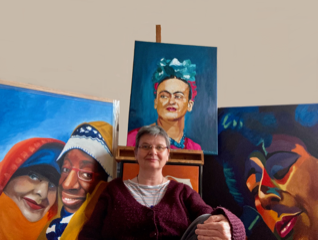An Interview with Karin Merx: On Portraiture as Storytelling, and Moving People with Art.
Karin Merx – Artists Feature – VAA Member of the Month June 2023
London based classically trained portrait painter and Art Historian, Karin Merx, explores using art to paint the stories of others, to tell your own story, and the ways in which art can move people.
Her artworks are often a combination of a classical style as well as bold and vibrant colours, making use of oils and occasionally acrylics. She notes that ‘portraits are the landscape of life’ and wishes to show the deep inner beauty of people by painting portaits as a story. Her slogan is: Own Your Beauty. She discovered her adoration or portraititure after reaching a particularly low point in her own life- which resulted in her book ‘We Share Out Stories: Survivors of Domestic Abuse’ and ‘Black Queer Role Models: Painting For Unity’.
‘Painting portraits is painting the stories of people.‘
My days are pretty strict. I am the proverbial early bird and so, my mornings start at 5 with meditation, morning pages and yoga. Then it depends on what I need to do, but I have come to terms of how to be an art entrepreneur and keep a simple schedule. Give me a choice and I am painting, but I also have to provide a newsletter, post on social media and keep up with it. Prepare my podcast, invite artists, art historians, curators etc. I paint preferably daily, but to be honest, that’s not always the case. Since I have a small studio in the flat where I live, I have the easel at hand, paper at hand and can sometimes already feel better after I placed a few brush strokes, or gazed long enough to see more and to feel that urge. Gladly the sun goes under later, winter times are definitely not my favourite because of the short window of time you have to paint or draw.


Painting portraits is painting the stories of people. Those stories are what you listen to when they tell them. Or, the family when a person is not there anymore. That also happens. But stories are a way to get that sense of knowingness that becomes deeper the moment you start with a sketch or start painting.
The more you listen – I always say active listen – the deeper you can go. Somehow the portraits are more alive. The art of storytelling is one I did when I still performed music. It is what I do now with painting, it is not about the performer or the painter, it is about the story the composer wrote or the sitter or people who commission you tell you.
In my opinion, that’s why those skills are so needed and necessary. I do not say photography is bad, I mean I use it as reference if I have nobody to sit but myself. Then still, the training to start with should always be through the observing of real people. It is by the way, also the way I take the people who commission me with me on that journey, and up until now, they really enjoy that because you make it about them or their loved one. Apart from that, they learn about the art practice.
‘I do not call them problems anymore, I call them challenges.‘
Honing my skills is part of what I do, and probably also who I am in general. I love to learn and to expand my skills. I am very much trained in the old master style, like in old, old master. Now I learn from the greatest contemporaries who I admire. So every portrait I paint will be like a new layer.
Growth is imperative for me. I could do with more sitters, but objects and my own self portrait is also good. I have this image in my head of where my art is going, it is part of my personal journey of where I want to be with my work. Today I have a specific painter who I deeply admire, when I have mastered that specific way I probably find a new ‘teacher’. That really keeps me going, keeps my heart sing also in more challenging times. That’s another way of tackling things, I do not call them problems anymore, I call them challenges. That makes it all lighter. It is my approach for life as well as my art.
Do you have a particular outlook that guides you?


Paint what you see, not what you think you see. That was my professor on the academy. He said that in that particular case, the curtains were deeply in the shadows, and so that is not in focus.
Another one was: the way you do one thing is the way you do everything. Every time I need it because I procrastinate, I get these messages, not once but several times.
The latest was: You Are What You Do, Not What You Say You’ll Do. I think we all need those reminders, because as artists we are not used to be entrepreneurs. So sometimes you can have ah, leave it for now.
Finally, what is your definition of artistic success?
Artistic success for me means that I paint portraits that move people, that touch them time and time again. It means that I come to the point that I have a vetted studio with great instructors to teach artists the needed skills of drawing and painting life, maybe have a movement of like minded and equally trained people. If I can reach people with that, it would mean the world to me and it would simultaneously mean that this so important skill doesn’t die out. Art Business success is when I earn more than enough to give back, can travel to paint and have my big studio with perfect light, to work and to teach.
